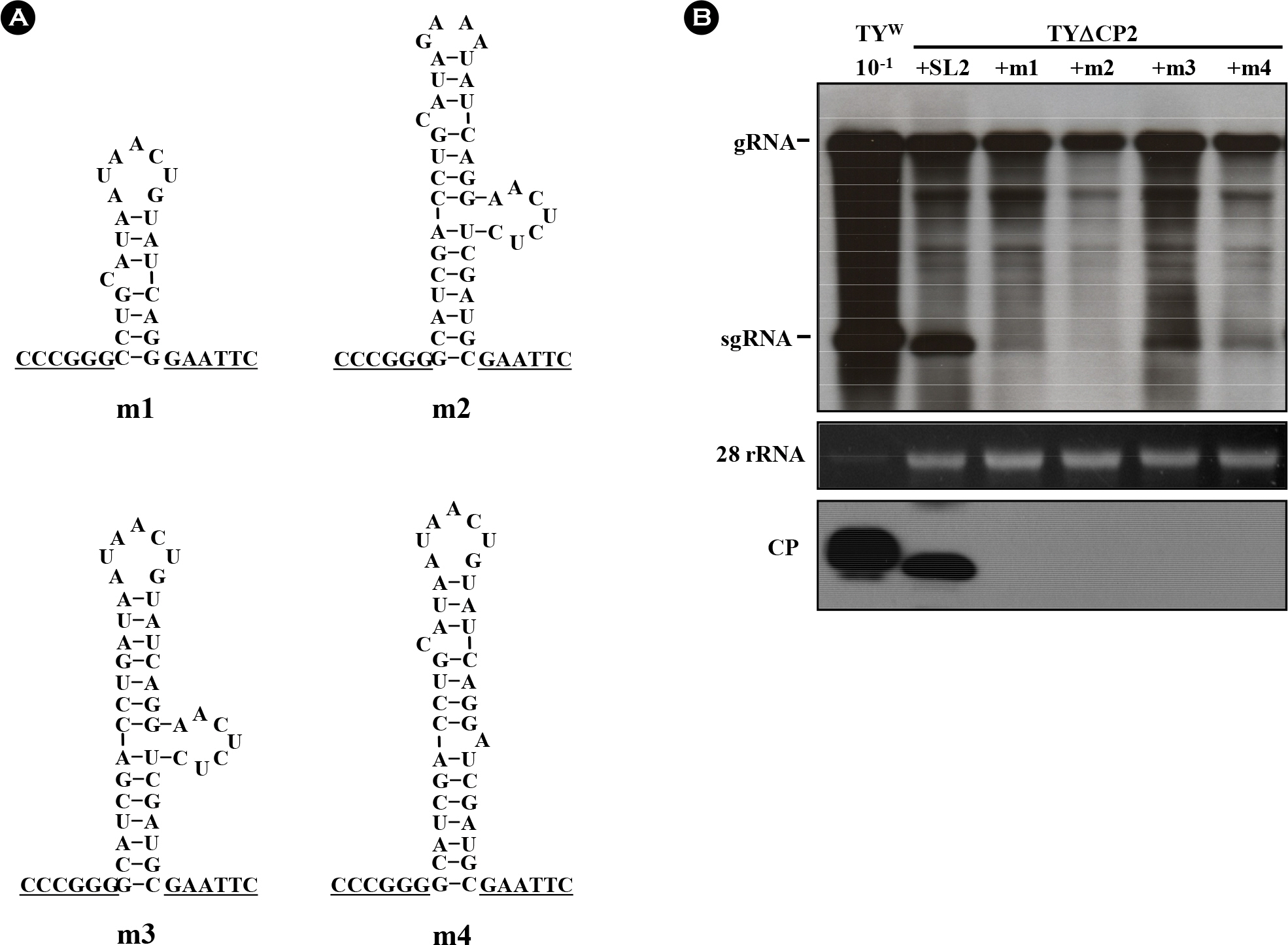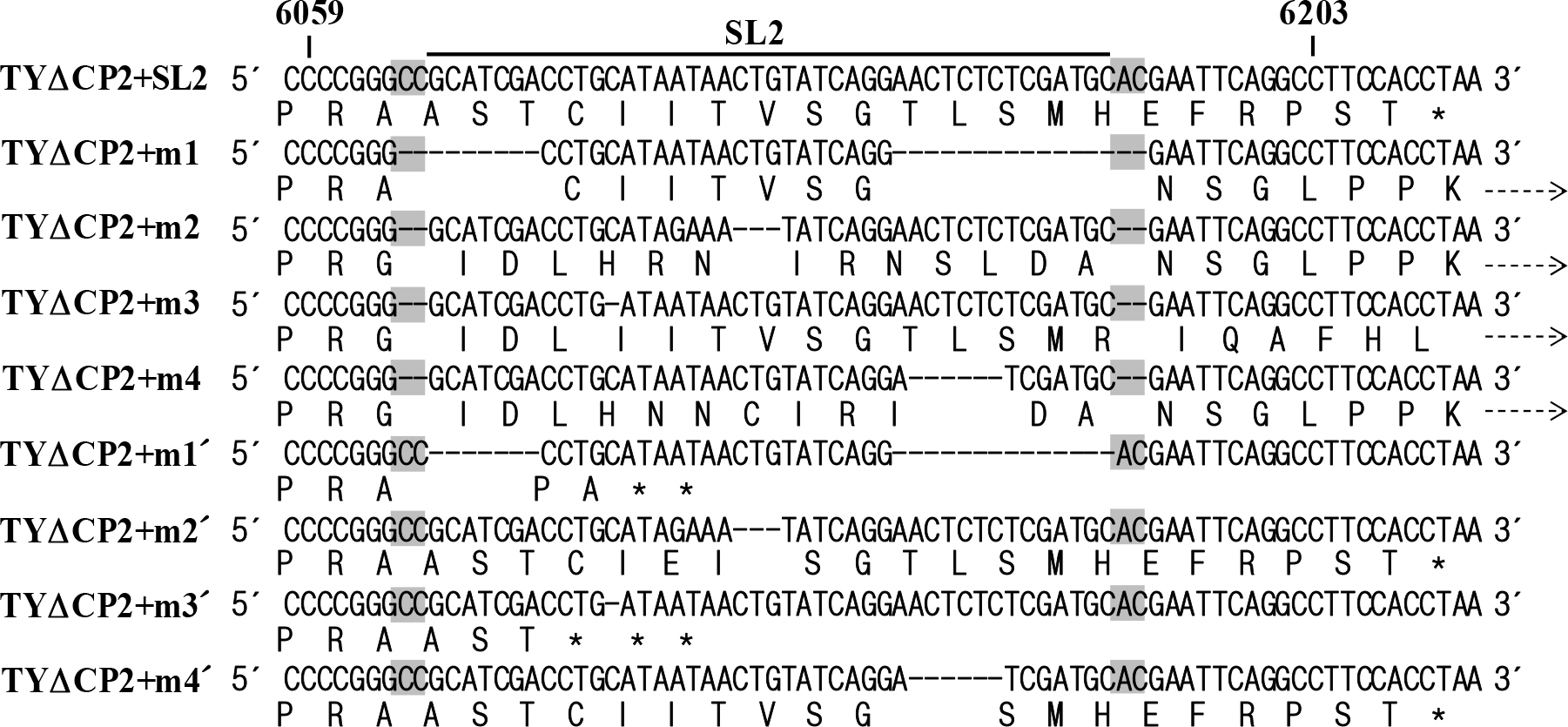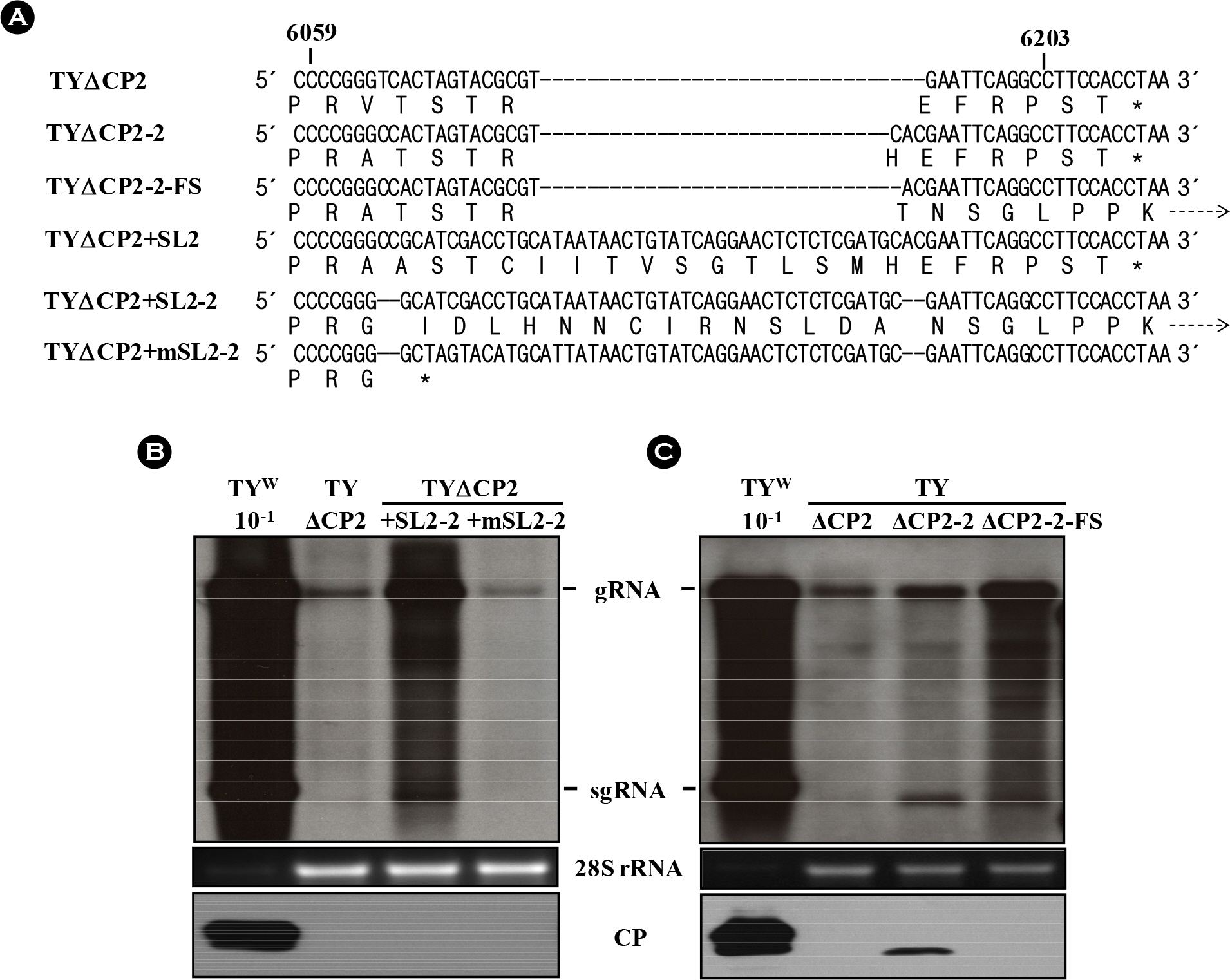J Bacteriol Virol.
2013 Mar;43(1):54-63. 10.4167/jbv.2013.43.1.54.
Read-through Mutation in the Coat Protein ORF Suppresses Turnip Yellow Mosaic Virus Subgenomic RNA Accumulation
- Affiliations
-
- 1Department of Biochemistry, Chungbuk National University, Cheongju, Korea. tjcho@chungbuk.ac.kr
- 2Division of Malaria and Parasitic Diseases, National Institute of Health, Korea Centers for Disease Control and Prevention, Cheongwon-gun, Korea.
- KMID: 1782703
- DOI: http://doi.org/10.4167/jbv.2013.43.1.54
Abstract
- We have previously observed that a sequence in coat protein (CP) ORF of Turnip yellow mosaic virus (TYMV) is required for efficient replication of the virus. The sequence was predicted to take a stem-loop structure, thus termed SL2. While examining various SL2 mutants, we observed that all the modifications resulting in extension of translation beyond the CP ORF significantly suppressed subgenomic RNA accumulation. The genomic RNA level, in contrast, was not affected. Introduction of an in-frame stop codon in the CP ORF of these constructs restored the level of subgenomic RNA. Overall, the results suggest that the read-through makes the subgenomic RNA unstable.
Keyword
MeSH Terms
Figure
Cited by 1 articles
-
N-terminal Extension of Coat Protein of Turnip Yellow Mosaic Virus has Variable Effects on Replication, RNA Packaging, and Virion Assembly Depending on the Inserted Sequence
Kwang-Hee Chae, Doyeong Kim, Tae-Ju Cho
J Bacteriol Virol. 2016;46(1):13-21. doi: 10.4167/jbv.2016.46.1.13.
Reference
-
1). Dreher TW. Turnip yellow mosaic virus: transfer RNA mimicry, chloroplasts and a C-rich genome. Mol Plant Pathol. 2004; 5:367–75.
Article2). Matsuda D, Dreher TW. The tRNA-like structure of Turnip yellow mosaic virus RNA is a 3′-translational enhancer. Virology. 2004; 321:36–46.
Article3). Matsuda D, Bauer L, Tinnesand K, Dreher TW. Expression of the two nested overlapping reading frames of Turnip yellow mosaic virus RNA is enhanced by a 5′ cap and by 5′ and 3′ viral sequences. J Virol. 2004; 78:9325–35.
Article4). Matthews REF. Tymovirus group. In Plant Virology. 3rd ed.San Diego: Academic Press;;1991. p. 231–9.5). Prod'homme D, Jakubiec A, Tournier V, Drugeon G, Jupin I. Targeting of the turnip yellow mosaic virus 66K replication protein to the chloroplast envelope is mediated by the 140K protein. J Virol. 2003; 77:9124–35.6). Jakubiec A, Notaise J, Tournier V, Héricourt F, Block MA, Drugeon G, et al. Assembly of turnip yellow mosaic virus replication complexes: Interaction between the proteinase and polymerase domains of the replication proteins. J Virol. 2004; 78:7945–57.7). Hellendoorn K, Michiels PJ, Buitenhuis R, Pleij CW. Protonatable hairpins are conserved in the 5′-untranslated region of tymovirus RNAs. Nucleic Acids Res. 1996; 24:4910–7.
Article8). Hellendoorn K, Verlaan PW, Pleij CW. A functional role for the conserved protonatable hairpins in the 5′ untranslated region of turnip yellow mosaic virus RNA. J Virol. 1997; 71:8774–9.
Article9). Shin HI, Tzanetakis IE, Dreher TW, Cho TJ. The 5′-UTR of Turnip yellow mosaic virus does not include a critical encapsidation signal. Virology. 2009; 387:427–35.
Article10). Deiman BA, Koenen AK, Verlaan PW, Pleij CW. Minimal template requirements for initiation of minus-strand synthesis in vitro by the RNA-dependent RNA polymerase of turnip yellow mosaic virus. J Virol. 1998; 72:3965–72.11). Deiman BA, Verlaan PW, Pleij CW. In vitro transcription by the turnip yellow mosaic virus RNA polymerase: a comparison with the alfalfa mosaic virus and brome mosaic virus replicases. J Virol. 2000; 74:264–71.12). Singh RN, Dreher TW. Specific site selection in RNA resulting from a combination of nonspecific secondary structure and -CCR- boxes: initiation of minus strand synthesis by turnip yellow mosaic virus RNA-dependent RNA polymerase. RNA. 1998; 4:1083–95.
Article13). Shin HI, Kim IC, Cho TJ. Replication and encapsidation of recombinant Turnip yellow mosaic virus RNA. BMB Rep. 2008; 41:739–44.14). Shin HI, Cho TJ. A sequence in coat protein open reading frame is required for Turnip yellow mosaic virus replication. J Bacteriol Virol. 2011; 41:109–16.
Article15). Shin HI, Cho TJ. Characterization of a replication element in the coat protein ORF of Turnip yellow mosaic virus. J Bacteriol Virol. 2012; 42:49–55.
Article16). Cho TJ, Dreher TW. Encapsidation of genomic but not subgenomic turnip yellow mosaic virus RNA by coat protein provided in trans. Virology. 2006; 356:126–35.
Article17). Miller WA, White KA. Long-distance RNA-RNA interactions in plant virus gene expression and replication. Annu Rev Phytopathol. 2006; 44:447–67.
Article18). Pogany J, White KA, Nagy PD. Specific binding of tombusvirus replication protein p33 to an internal replication element in the viral RNA is essential for replication. J Virol. 2005; 79:4859–69.
Article19). Dreher TW. Functions of the 3′-untranslated regions of positive strand RNA viral genomes. Annu Rev Phytopathol. 1999; 37:151–74.
Article20). Dreher TW, Uhlenbeck OC, Browning KS. Quantitative assessment of EF-1alpha. GTP binding to aminoacyl-tRNAs, aminoacyl-viral RNA, and tRNA shows close correspondence to the RNA binding properties of EF-Tu. J Biol Chem. 1999; 274:666–72.21). Dreher TW, Miller WA. Translational control in positive strand RNA plant viruses. Virology. 2006; 344:185–97.
Article
- Full Text Links
- Actions
-
Cited
- CITED
-
- Close
- Share
- Similar articles
-
- A Sequence in Coat Protein Open Reading Frame Is Required for Turnip Yellow Mosaic Virus Replication
- Replication of Recombinant Flock House Virus RNA Encapsidated by Turnip Yellow Mosaic Virus Coat Proteins in Nicotiana benthamiana
- Characterization of a Replication Element in the Coat Protein ORF of Turnip Yellow Mosaic Virus
- N-terminal Extension of Coat Protein of Turnip Yellow Mosaic Virus has Variable Effects on Replication, RNA Packaging, and Virion Assembly Depending on the Inserted Sequence
- Genome Size Constraint in Replication and Packaging of Turnip Yellow Mosaic Virus







